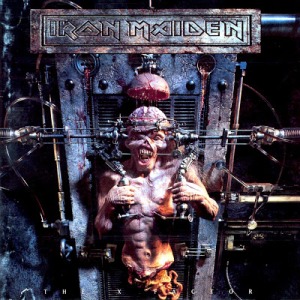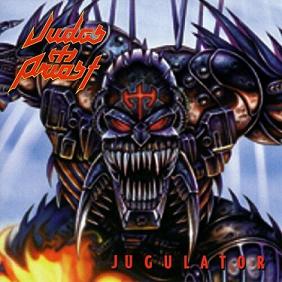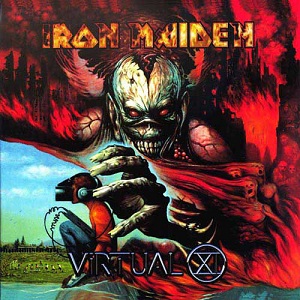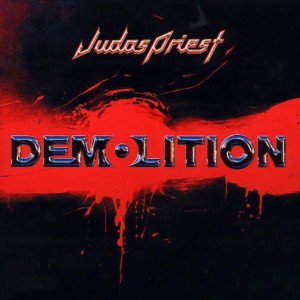Despite having developed into one of the most successful Heavy Metal bands on the planet during the 1980s, Iron Maiden entered the 90s in a state of crisis. The musical climate was changing around them; most notably, Americs’a ‘Big Four’ Thrash Metal bands had erupted from the underground and were making serious inroads into the Metal universe, threatening the Maiden throne. The key to Iron Maiden’s massive global success in their first decade was their blend of 70s Prog rock and Punk-inspired Heavy Metal, and the band closed out the 80s with increasingly prog-leaning albums like ‘Somewhere in Time’ and ‘Seventh Son of a Seventh Son’… Enter the young, angry upstarts from across the pond to ‘smash it up’ and destroy the status quo. Those who know their music history will find plenty of Iron-y (heh) here.
Steve Harris made some decisions. The music on Maiden’s eighth album would be simpler, stripped-down and more direct, closer to the band’s earlier sound. The change in direction was so drastic that Adrian Smith left the band during pre-production. The resultant album, ‘No Prayer for the Dying’, was a near-complete regression back to the street-level, headbanging vibe of Maiden’s early years. The lyrics covered real-world concerns such as oppression, religion and politics, all sung by Bruce Dickinson in a rougher, raspier voice. Even the artwork reflected the ‘new’ direction, depicting Eddie (sans lobotomy bolt and cyborg augmentation) smashing out of his tomb to strangle a hapless gravedigger, a far cry from Eddie the reality-bending cosmic existentialist from the previous album.
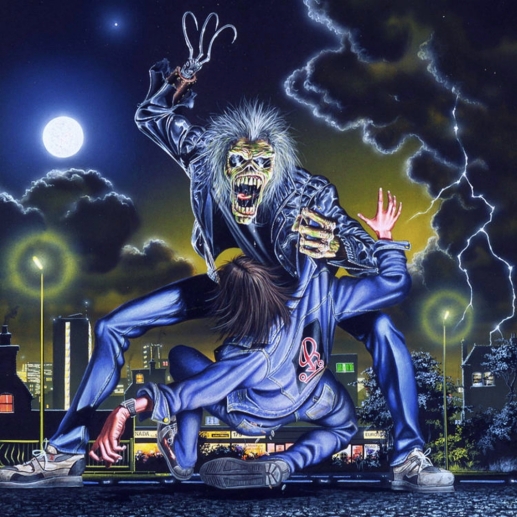
‘Prayer’ rejects ‘Arry’s progressive tendencies and just gets on with it. Not one of the album’s 10 tracks breaks the 6-minute mark, and the whole record runs at a tight (for Maiden) 43:42, almost 10 minutes shorter than both ‘Powerslave’ and ‘Somewhere in Time’. But Harris couldn’t completely resist his Prog compulsion; the album’s closer, ‘Mother Russia’, contains several progressive elements, although it’s multiple movements and ambitious historical sweep are constrained to a mere 5:30. Still, ‘Mother’ feels like an awkward edit of a 10-minute ‘Arry epic, and sounds out of place on an album of much more concise and immediate material.
So Iron Maiden had forced themselves back to square one, denying the Prog beast within and returning to their roots to do battle with Metal’s next wave. Did the change in direction work? In the UK, ‘Prayer’ reached #2 and the album’s second single was Iron Maiden’s first-ever UK #1. In the States, the album held it’s own, but the the Thrash Metal movement was in it’s heyday, and Metallica now dominated the Metal conversation. ‘No Prayer for the Dying’ went Gold in the US, but it would be the last Iron Maiden album ever to do so. Maiden’s return to their roots was perhaps too little, too late.
What to try next, then? How about… everything! On ‘Fear of the Dark’, Maiden’s 9th album, confusion reigns. It’s the first Maiden album not produced by Martin Birch; it’s also the first Maiden record not adorned with the artwork of Derek Riggs. The music within reveals a band struggling for direction, identity and relevance, featuring full-on Metal, a power ballad, and yes, the (welcome?) return of Steve Harris’ beloved Prog. And with the return of progressive elements to Maiden’s music came expanding song lengths: two of ‘Arry’s contributions stretch past 6 minutes, and the total record was the longest ever in Iron Maiden’s history, at 57:58, just shy of an hour.
Regardless of their length, it’s the Harris-penned tunes on ‘Fear of the Dark’ that sound most like classic Maiden. ‘Arry’s ‘Afraid to Shoot Strangers’ and the album’s title track are standouts; both creep past 6 minutes and reach back to the expansive, indulgent sound of just a few years previous. While overall it’s an uneven listen, ‘Fear’ topped the UK charts, giving Maiden their first-ever UK No. 1 album, and charted higher in the US than ‘Prayer’. Hmmm… Maybe re-asserting Steve Harris’ Prog side was the way to go next…
GAAHHHHH! On Maiden’s tenth album, ‘The X Factor’, Harris unleashes the Prog beast, and it runs rampant over this 70-minute disaster. Opening with the 11-minute slog ‘Sign of the Cross’ sets the stage for a looooong, mid-paced trudge through the tortured landscape of Steve Harris’ psyche. The bassist was dealing with a difficult divorce while writing the album, and his name is on 10 of the 11 songs here; only ‘Man on the Edge’, written by new singer Blaze Bayley and guitarist Janick Gers, trots along at a proper Maiden-esque pace. ‘Edge’ is the shortest tune on a record where half the songs move well past the 6-minute mark, and every track feels like a 10-minute epic. Maiden had shown in the past that they could ably hold the listener’s interest through songs of extended lengths… here they fail spectacularly.
It’s interesting to note that that three songs were recorded for the album, ‘Justice of the Peace’, ‘I Live My Way’, and ‘Judgement Day’, but were not included on the finished product. All three clock in between 3:33 and 4:04, significantly shorter than anything that made the final cut, and all three are up-tempo rockers sporting tight, concise arrangements that hearken back to Maiden’s glory years. This would indicate that building an album comprised of over-long, melodramatic downers was an artistic choice. ‘Arry’s head space has been called into question during critical examinations of ‘X’; obviously Steve Harris was in a very dark place during the creation of this record.
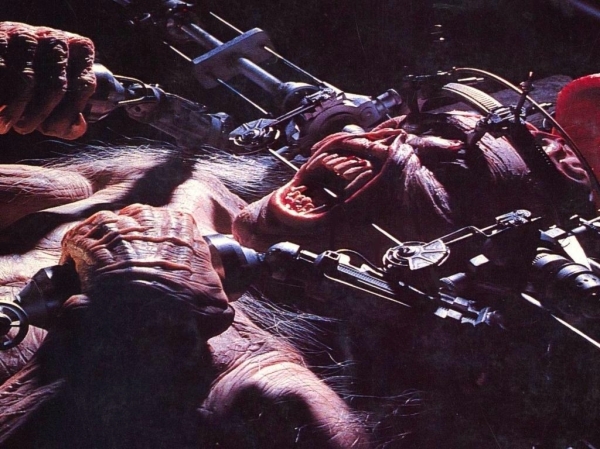
It’s amazing that Maiden survived the ‘X Factor’ debacle, and a testament to their iconic status and bullet-proof reputation that the album reached #8 in the UK. In the US, however, the record peaked at a dismal #147, where ‘Fear of the Dark’ had climbed to #12 just three years previous. Dickinson’s absence was a factor, as was the album’s repulsive cover art. But 70 minutes of poisonous Prog metal sealed the deal: ‘The X Factor’ was a deal-breaker for many US fans, who walked away from the band for good.
In 1996, Maiden released a non-lp single to promote an compilation album. ‘Virus’ was 6 minutes and 14 seconds of classic ‘Arry Prog indulgence, and it solidified a pattern that would become a template for several (too many) Maiden songs to come: an extended intro featuring whispered vocals, moody synth backdrops and delicately played guitars, kicking into a classic Maiden gallop with harmony guitars on top. The trouble is, the quiet, slow-moving introduction lasts for 2:20, which is 40% of the song. An edit of ‘Virus’ was released to radio, which removed the intro completely, slamming immediately in with the classic Maiden sound of yore. There was a lesson to be learned here; trim the fat, cut the excess, strive for maximum impact… ‘Arry was having none of it.
Maiden’s next, ‘Virtual XI,’ was almost 20-minutes shorter than ‘X’; however, the Prog bloat persisted. The album features 3 extended pieces, one at 8:11, the other two at 9:51 and 9:06, all written solely by (surprise!) Steve Harris. Oddly, the album’s longest song, ‘The Angel and the Gambler’, was chosen as the first single. At over 9 minutes, the song had no chance at commercial radio, so an edit was also released, running at 6:05… also too long for commercial radio. The questionable choice for lead-off single was compounded by the song’s arrangement: the chorus of “Don’t you think I’m a savior? Don’t you think I could save you? Don’t you think I could save your life?” is repeated so many times that it makes me want to stab myself in the eye. Even the edited version sends me searching for sharp objects.
The Blaze era was an artistic and commercial failure when compared to what had come before. Take a second to remember the urgency and immediacy of their early work; a catchy guitar riff, the band kicks in seconds later, and we’re off to the races! Now it seemed that every other song started with an extended atmospheric intro. Grandiose epics had become commonplace, which minimized their impact and strained our patience, when in the early years, longer songs like ‘Phantom’ and ‘Mariner’ were anomalies that felt special and exciting. Without Bruce interpreting his material and Adrian Smith’s pop sensibilities reigning in the songwriting excess, ‘Arry’s progressive streak was barreling out of control and the SS Maiden was sinking under the epic weight of their bassist’s ever-expanding vision.
Someone needed to put the Prog genie back in the bottle. Surely the return of ‘Arry’s old writing partners would right the ship and Iron Maiden would pick up just where they left off with ‘Seventh Son’! Well… Kinda. But not really. Bayley departs, Dickinson and Smith return… but Gers stays put. As if to highlight Harris’ ‘more is more’ philosophy, the band itself expanded to six members. Now armed with three guitarists, was there any chance of more economical song lengths, any hope of more compact arrangements, with three guitarists jockeying for solo spots in every song? Or would the addition of two members from Maiden’s most successful period temper the excess and impose some moderation onto the proceedings?
Alas, the Prog continued it’s expansion, unabated. Album total run times ballooned with each release:
‘Brave New World’ 66:57
‘Dance of Death’ 67:57
‘A Matter of Life and Death’ 71:53
‘The Final Frontier’ 76:34
Which brings us to 2015 and ‘The Book of Souls’.
While I understand the mindset that says ‘there’s a 4 or 5-year gap between albums so let’s give ’em as much music as we can’, the total length of each album isn’t the only reason that Maiden albums have become so… unwieldy. Nowadays, Maiden songs that run 5 minutes or less are now the anomalies; on ‘The Book of Souls’, there are three songs that sail past the 10-minute mark, and the album contains their longest-ever song, ‘Empire of the Clouds’, an 18-minute super-mega-epic about… zeppelins. ‘Arry’s ‘The Red and the Black’, at `13:33, would be a fitting final tour de force to close any of Maiden’s previous albums; on ‘Souls’, it’s only Track #4 of 11… And the song never ends! Just when you think it’s winding up, it changes up and keeps rolling on… and on… and on…
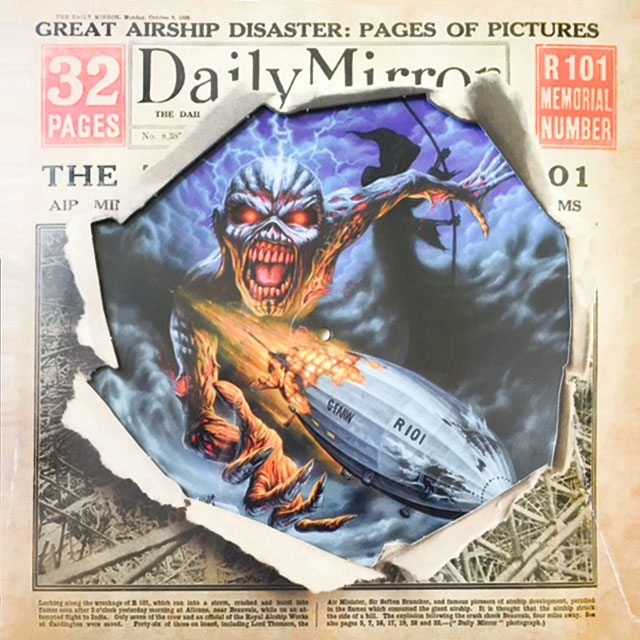
While I believe ‘Souls’ to be the best of the last five Maiden releases, my assessment is based on a single listen. Why? It took me days to get all the way through ‘The Book of Souls’ in its entirety. With each visit, I’d inevitably find myself losing focus, especially in the longer songs, as my mind drifted while the music blended with the wallpaper. The monstrous length of the album and most of the songs on it are just too much for me. I’ve considered giving the ‘Souls’ CD(s) a second spin, but always decide against it; the prospect feels too daunting, too massive an undertaking, too much of an investment of time and attention. I liked what I heard the first time through, but it will be a long time before I climb that mountain again.
Yes’ ‘Tales From Topographic Oceans’, a polarizing progressive rock milestone notorious for its overwhelming length and complexity, has become a symbol of overblown Prog excess. ‘The Book of Souls’ is 10 minutes longer. The needle on Iron Maiden’s progometer has been ‘in the red’ for about 20 years now, and with ‘Souls’, their progressive readings are off the charts. It’s as if Steve Harris has been steadily working to emulate his favorite piece of music: the 23-minute ‘Supper’s Ready’ by Genesis. Enough, already! News Flash: ‘Run to the Hills’, ‘Sanctuary’, ‘The Trooper’, ‘Wrathchild’, ‘Aces High’, ‘The Evil That Men Do’… All classics… all under 5 minutes! Message to ‘Arry: Every song can’t be ‘Supper’s Eddie’!

![iron-maiden-seventh-son-of-a-seventh-son-vinyl-record-lp-emi-1988-[5]-40552-p](https://mayobat.files.wordpress.com/2017/08/iron-maiden-seventh-son-of-a-seventh-son-vinyl-record-lp-emi-1988-5-40552-p.jpg?w=553&h=544)
